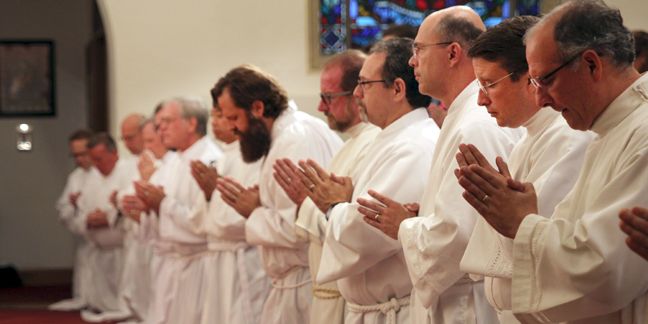Bishop, Priest & Deacon
Those of you who stayed after Mass last night know that we had a visiting Ukrainian Rite deacon with us, Father Deacon Kevin Bezner. At the end of the evening I asked the deacon to give a blessing for us, forgetting momentarily that Eastern Rite deacons don’t do that sort of thing. (Western, or Roman Rite deacons may offer blessings not reserved for a priest or a bishop). The good deacon casually replied that he “can’t” bless. I corrected him, saying that he “can, but may not,” and then Father Voitus said something that sounded very technical and canonical and probably went right over everyone’s heads. (That’s ok if it did!)
 So the deacon offered a prayer for us, Father gave a blessing, and all was well with the world. The whole exchange described above played out in a few seconds and you may have missed it. But it provides an opportunity to make a point about the relationship between the deacon and/or priest and his bishop.
So the deacon offered a prayer for us, Father gave a blessing, and all was well with the world. The whole exchange described above played out in a few seconds and you may have missed it. But it provides an opportunity to make a point about the relationship between the deacon and/or priest and his bishop.
The Catholic Church has a three-fold hierarchy of Holy Orders: bishop, priest and deacon. There is only one sacrament of ordained, apostolic ministry, but three “degrees” or orders of that sacrament. Once a man is ordained into an order, he can never be “unordained.” So a deacon does not cease to be a deacon if he is ordained a priest. A priest does not cease to be a priest if he is ordained a bishop. Only the bishop, then, has the fullness of Holy Orders, as he is deacon, priest and bishop together. Only the bishop is the successor of the Apostles, and ministers of his own right with Apostolic authority. The ministry of the priest and the deacon is an extension of the ministry of the bishop, and can only be undertaken with the authorization of the bishop. We refer to this as “faculties.” If a priest or a deacon does not have faculties from his bishop, he cannot perform ministerial duties. (This does not mean he is no longer a priest or deacon, it simply means he cannot exercise ministry as such).
Holy Orders are the same whether one is speaking of the Western or Eastern branches of the Church. A Byzantine (Eastern) Rite priest is just as much a priest as a Roman Rite priest. They participate in the same priesthood of Christ. A Roman deacon and an Eastern deacon are ordained into the same diaconate.
As I mentioned before, deacons in the Roman Rite can and do offer blessings. They can offer any blessing that is not specifically reserved to a priest or a bishop. As there is no ontological difference between Eastern deacons and Roman deacons, an Eastern deacon can offer the same blessings that a Roman deacon can. But deacons in the Eastern Rites operate under a different discipline than western deacons do. Eastern Rite deacons do not have faculties to offer blessings, and so they may not, even though they are ordained to the same diaconate as their Roman counterparts. No cleric may exercise any ministry he has not been granted faculties for by his bishop.
Normally lay people only hear about “faculties” if a cleric has been behaving badly and has his faculties revoked by his bishop as a punitive measure. But, as was illustrated last night, it also comes into play when we are considering the different Rites in the Catholic Church, and the different faculties certain orders of clerics are or are not granted according to the traditions of those Rites.
This three-fold ministry of Holy Orders is certainly nothing new. In fact, it has been around since the very beginning of the Church.
“You must all follow the bishop as Jesus Christ follows the Father, and the presbytery [priests] as you would the apostles. Reverence the deacons as you would the command of God. Let no one do anything of concern to the Church without the bishop. Let that be considered a valid Eucharist which is celebrated by the bishop, or by one whom he appoints. Wherever the bishop appears, let the people be there; just as wherever Jesus Christ is, there is the Catholic Church.”
The above quote comes from St. Ignatius of Antioch, writing to the Church in Smyrna c. 110 AD. St. Ignatius, bishop and martyr, learned the Christian faith from the Apostle John, and was chosen to be bishop of Antioch when St. Peter, who founded the Church there, went to found with St. Paul the Church in Rome. While we certainly must acknowledge certain external differences between the Church of the first few generations of Christians and the Church of today, it is noteworthy to see how much remains the same.
Read more about what the early Church fathers have to say about bishops, priests and deacons here.

